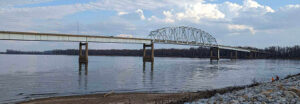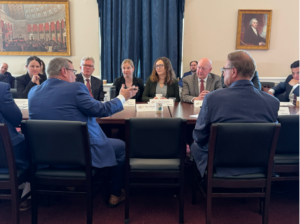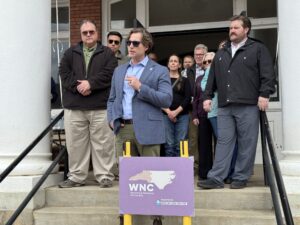Adaptation Working Group Letter to the 118th Congress
On March 5, 2024, American Flood Coalition Action coordinated a letter to the 118th Congress with the Adaptation Working Group.
The Honorable Charles Schumer
Democratic Leader, U.S. Senate
Washington, DC 20510
The Honorable Mitch McConnell
Republican Leader, U.S. Senate
Washington, DC 20510
The Honorable Mike Johnson
Speaker, U.S. House of Representatives
Washington, DC 20515
The Honorable Hakeem Jeffries
Democratic Leader, U.S. House of Representatives
Washington, DC 20515
Dear Leader Schumer, Leader McConnell, Speaker Johnson, and Leader Jeffries:
The undersigned organizations are members of the Adaptation Working Group and other like-minded organizations. The Adaptation Working Group is a coalition of national organizations that represent a broad array of stakeholders — local governments, disaster response and recovery professionals, conservationists, underserved populations, resilience policy specialists, and more — who believe that the federal government should prioritize and promote community resilience and adaptation to flooding. In 2023, we recommended six resilience priorities for Congress to consider when developing policy:
- 1. Simplify programs to reduce barriers and expand access.
- 2. Invest in our most at-risk communities.
- 3. Empower communities to implement the most beneficial adaptation solutions to fit their unique needs.
- 4. Use updated data to plan for the future.
- 5. Focus on comprehensive regional efforts and coordinate these efforts nationally.
- 6. Train the climate adaptation and resilience workforce.
Since urging Congress to take action on these priorities last January, the United States experienced 28 separate billion-dollar weather and climate disasters, making 2023 the year with the most billion-dollar disasters in the U.S. on record.1 Additionally, many regions across the country continue to experience extreme weather, including increasingly intense and destructive rainfall that overwhelms stormwater infrastructure and floods homes and businesses.2
As a country, we face a critical moment to reimagine infrastructure design, federal grant programs, and disaster recovery processes. As Congress concludes the business of the 118th Congress this year, the Adaptation Working Group encourages Congress to take action to build a more resilient nation and consider the following proposals:
Simplify programs and enhance efficiency to reduce barriers for access
To get back on their feet, many disaster survivors apply for Federal Emergency Management Agency (FEMA) Individual Assistance and Small Business Administration (SBA) loans. However, FEMA and SBA programs have separate application processes, creating confusion and forcing disaster survivors to duplicate efforts. Congress can reduce the burden on survivors seeking relief from these and other federal programs with legislation like S. 1528, the Disaster Assistance Simplification Act, and provisions within H.R. 1796, Disaster Survivors Fairness Act that direct FEMA to create a web-based, universal intake process and system for disaster assistance applicants. This new system allows individual survivors to submit a single application for aid across the federal government’s disaster assistance programs.
Further, to make long-term disaster recovery efforts more efficient and impactful, Congress should permanently authorize the Department of Housing and Urban Development (HUD) Community Development Block Grant Disaster Recovery (CDBG-DR) program. Since 1992, Congress has appropriated roughly $100 billion through CDBG-DR, making it the primary federal resource for long-term recovery. However, the program has never been permanently authorized, relying instead on supplemental appropriations from Congress and Federal Register notices from HUD. This lengthy, cumbersome process leads to slower and weaker recoveries. S. 1686, the Reforming Disaster Recovery Act, permanently authorizes CDBG-DR and establishes a funding mechanism to more efficiently deploy CDBG-DR funding in response to catastrophic disasters. S. 1686 would substantially increase the speed of assistance delivery and give communities greater certainty as they build back after a disaster, while also reducing future risks.
Invest in our most at-risk communities
Some of the most vulnerable populations to extreme weather and flooding are disadvantaged communities whose residents may not know their flood risk and/or lack resources to purchase flood insurance. According to FEMA, those without flood insurance in the highest risk areas tend to have lower incomes, and 51% of non-policyholder households in high-risk areas are low income.3
Congress must address this insurance gap by passing a long-term reauthorization of the National Flood Insurance Program (NFIP) that establishes a means-tested flood insurance affordability program to help low- and moderate-income homeowners and renters purchase flood insurance.
Sufficient flood insurance coverage is critical to financially protecting vulnerable households from devastating flooding: After Hurricane Harvey in 2017, the average FEMA individual assistance payment was $4,400, whereas the average NFIP claims payment was $116,800.4
Congress should prioritize affordability for people who lack the means to cover their homes. More affordable flood insurance will increase insurance uptake and reduce federal spending on post-disaster aid, while still effectively communicating flood risk to those affected.
Empower communities to implement the most beneficial adaptation solutions to fit their unique needs
Agriculture is one of America’s original conservation industries, intimately connected to the land and environment. Farmers, ranchers, and foresters understand the impacts of extreme weather and have a vested interest in smart solutions to protect their land. To effectively plan for the future, however, they must know that the innovative practices they have adopted will continue to reduce risk and maximize household income. When farmers engage in innovative practices such as multicropping, for example, they can reduce flooding by 40–60%, while yielding an average $50.90 higher net profit per acre.5
Long-term reauthorization and continued funding of the Farm Bill’s conservation programs would give farmers peace of mind and incentives for using their land to bolster regional flood resilience. The voluntary programs of the U.S. Department of Agriculture (USDA) Natural Resource Conservation Service (NRCS) and Farm Service Agency (FSA) provide essential funding and technical assistance to help producers manage their land and carry out innovative flood solutions.
The NRCS Emergency Watershed Protection (EWP) program plays an essential role in disaster recovery for rural areas. As Congress works toward a bipartisan Farm Bill, it should consider marker legislation such as S.3147, the Flood Protection and Infrastructure Resilience Act, and H.R.5250, the Flooding Prevention, Assessment, and Restoration Act. S.3147 and H.R.5250 add flexibility to the EWP program by allowing communities to build back from disasters with more protection to avoid repetitive damage.
Other bipartisan marker bills to consider are S. 3500 / H.R. 6811 Natural Climate Solutions Research and Extension Act. S. 3500 / H.R. 6811 designate natural climate solutions as a high priority for research and extension services at USDA, opening funding sources to researchers identifying the best land management practices to protect America’s farmland. Congress should empower farmers with scientifically-proven guidance to improve farm outcomes and build resilience, and S. 3500 / H.R. 6811 moves this effort in the right direction.
Use updated data to plan for the future
By enacting Public Law 117-316,6 Congress showed bipartisan leadership on the urgent need to provide states and communities with comprehensive federal precipitation data that reflects future risk. With funding from the Infrastructure Investment and Jobs Act, the National Oceanic and Atmospheric Administration (NOAA) is working to develop Atlas 15,7 which will provide comprehensive precipitation frequency estimates that reflect future conditions for the entire U.S. and its territories. NOAA’s existing precipitation datasets, known as Atlas 14, are a foundation for the design and construction of most built infrastructure nationwide. Unfortunately, this data is often outdated and incomplete and fails to account for future conditions. Research by the First Street Foundation finds that over half the U.S. population live in or near areas that are twice as likely to experience severe rainfall events, as compared to the findings from Atlas 14.8
Fortunately, NOAA is hard at work on developing Atlas 15, with plans to distribute preliminary estimates in 2025 for the contiguous 48 states. With states and communities already investing in infrastructure, Atlas 15 cannot come soon enough. While maintaining its rigorous scientific methodology and processes, NOAA should accelerate steps to get preliminary data into the hands of planners and engineers as they weigh how to build future-ready infrastructure that can also reduce loss of life and property from flooding.
We urge Congress to support accelerated development and deployment of both preliminary and final Atlas 15 products, ensuring our infrastructure is built to last through future conditions.
Focus on comprehensive regional efforts and coordinate these efforts nationally
Congress should make it easier for state and local governments to manage flood risk and recovery at a watershed scale. Because water does not follow municipal or county boundaries, efforts to focus on watershed health and intergovernmental coordination maximize federal investment. Legislation like S.757 / H.R.1670, the Making Access To Cleanup Happen (MATCH) Act, allows local governments to begin cleaning up watersheds through pre-approved project types after a flood without risking access to recovery funds from USDA. Current law requires communities to wait for USDA to approve projects before beginning clean-up activities that may count toward their non-federal cost share for other recovery programs. We further recognize that the functioning of natural features throughout a watershed is necessary for flood resilience writ large; thus, by removing debris and restoring the natural function of a watershed as soon as possible, local entities reduce the risk of a follow-on flood event.
While watershed recovery and rehabilitation are important for safeguarding against repeated flooding, the federal government should encourage states to have a long-term adaptation and resilience vision, with projects grounded in an organized, regional adaptation plan that aligns with an overarching federal strategy. To this end, we are encouraged by the introduction of S. 3261 / H.R. 6311, the National Coordination on Adaptation and Resilience for Security (NCARS) Act. This bipartisan proposal requires a whole-of-government federal resilience strategy that details efforts to defend against flooding and extreme weather and ensures policies and resources support historically underserved, frontline communities. NCARS aligns the federal government’s resilience and adaptation efforts to maximize local impacts.
Train the climate adaptation and resilience workforce
Congress should take a concerted, bipartisan approach to developing a modern resilience and adaptation workforce prepared to defend communities and local economies against natural hazards. The 118th Congress has introduced legislation that would develop a national strategy to build this resilience-focused workforce, but unfortunately, these efforts have yet to progress through the legislative process.
Every state and congressional district is home to numerous construction workers, tradespeople, public works professionals, and engineers who work tirelessly to ensure their community has running water, operating wastewater treatment facilities, and functioning stormwater infrastructure. Each of these water management practices is increasingly susceptible to flooding: from toxic pollution entering drinking water sources during floods to protecting wastewater treatment facilities from floodwaters to maintain facility operations. With this in mind, we renew our request for the federal government to collaborate with industry, labor, and education stakeholders to assess workforce needs and support modern training and Registered Apprenticeship programs for career fields expanding into adaptation and resilience — including incentives to participate in proven and innovative training programs. Developing a robust workforce prepared to solve these challenges is key to building our national resilience to future flooding and other natural hazards, while boosting local economies.
The need to adapt to extreme weather patterns is great, but the current opportunity for Congress to lead on solutions that protect lives, homes, and communities is even greater. We hope you consider the legislation highlighted in this letter to build a more resilient nation. We look forward to supporting you in this mission.
Sincerely,
American Flood Coalition Action
Bipartisan Policy Center Action
American Public Works Association (APWA)
Appalachian Citizens’ Law Center
Appalachian Voices
BuildStrong America
Environmental and Energy Study Institute (EESI)
National Audubon Society
Rural Community Assistance Partnership (RCAP)
SBP
Smart Growth America
Theodore Roosevelt Conservation Partnership
Woodwell Climate Research Center
###
About the American Flood Coalition Action
American Flood Coalition Action is a 501(c)(4) dedicated to advancing national solutions to the reality of higher seas, stronger storms, and more frequent flooding. We raise awareness around these pressing issues and drive reforms that will aid flood-affected communities in disaster mitigation and smart planning for the future to protect our nation’s residents, economy, and military installations.
About Adaptation Working Group
Adaptation Working Group — led by the American Flood Coalition and Bipartisan Policy Center — is a coalition of national organizations that represent a broad array of stakeholders — local governments, utilities, disaster response and recovery professionals, conservationists, underserved populations, resilience policy specialists, and more — who believe that the federal government should prioritize and promote community resilience and adaptation to flooding.
Endnotes
1 “U.S. struck with historic number of billion-dollar disasters in 2023.” National Oceanic and Atmospheric Administration (NOAA), Jan 2024.
2 National Centers for Environmental Information. (2024, February). Climate Indicators. U.S. Department of Commerce, National Oceanic and Atmospheric Administration.
3 “NFIP Affordability Report to Congress.” Federal Emergency Management Agency (FEMA), 17 April 2018.
4 “Private Flood Insurance and the National Flood Insurance Program.” Congressional Research Service, 7 May 2019.
5 “AFC pilot: Scaling agricultural practices to address flooding.” American Flood Coalition, 29 Aug 2023.
6 P.L. 117-316, the Flood Level Observation, Operations, and Decision Support Act.
7 “NOAA ATLAS 15: Update to the National Precipitation Frequency Standard.” National Oceanic and Atmospheric Administration, 2024.
8 “The 8th National Risk Assessment: The Precipitation Problem.” First Street Foundation, 26 June 2023.





